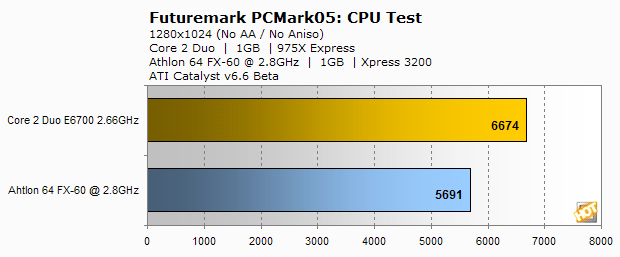Intel Core 2 Duo Performance Update
Earlier this month we gave you a taste of what AMD has to offer in their next generation AM2 platform launch for the Athlon 64. While AMD's new DDR2-based platform seems to offer smallish incremental performance gains, and increased memory bandwidth, it is widely agreed that it is high-time that Intel responds to AMD's consistent re-occurring competitive threat, with something more on an exponential level. It's also widely understood that Intel response will finally come with the imminent release of Intel's Core 2 Duo CPU, code named Conroe.
Staying back state-side, opting to miss out on this year's Computex extravaganza over in Taiwan, we've been hard at work with Intel Product Managers, Architects and Senior PR Managers, exploring the performance and architecture of Intel's forthcoming Conroe core CPU. This week, in an intimate closed-door session at an exclusive meeting with Intel in New York, we got in some quality time with Conroe and we have more performance characterization results for you here. While some publications have resorted to back-channel hacking together of hardware, unsanctioned by Intel, we have the real deal for you.
Unfortunately, we were again unable to build-up and configure the test rigs ourselves, similar to the situation we were in back in March when we first previewed Conroe performance from IDF in San Francisco. We did spend some time, however, snooping through the BIOS and OS and have confidence in the performance metrics we'll be presenting here. If you look back at our FX-62 coverage, you'll see that the overclocked 2.8GHz FX-60's performance referenced in the proceeding graphs scales appropriately.
|
|
|




Core 2 Duo E6700 (2.66GHz) CPU-Z Details




Core 2 Extreme X6800 (2.93GHz) CPU-Z Details
Before we got to the business of benchmarking, we fired up CPU-Z to get a deeper look at the Core 2 Duo, and the platform that we tested it on. Please note, that the 1600MHz clock speed reported by CPU-Z was a result of Intel's SpeedStep technology cranking down the CPU frequency to conserve power. Also note the full 4MB of cache reported for both CPUs, and the newer stepping of the Core 2 Extreme.
|
|
|
|
System 1: Radeon X1900 XT CrossFire 1GB (512MBx2) DDR2 800 4-4-4-4-12 2.66GHz Core 2 Duo 2.93GHz Core 2 Extreme Intel D975XBX "BadAxe" Maxtor 6L300SO HD Antec 550w PSU Windows XP SP2 ATI Catalyst v6.6 Beta |
System 2: Radeon X1900 XT CrossFire 1GB (512MBx2) DDR 400 2-2-2-5 A64 FX-60 @ 2.8GHz Asus A8R32-MVP Deluxe Maxtor 6L300SO HD Antec 550w PSU Windows XP SP2 ATI Catalyst v6.6 Beta |
* Note - We also encourage you to reference our AMD Socket AM2 Platform numbers, here. As baseline reference, the scores in this article will provide insight into what a similarly configured DDR2-based Athlon 64 FX-62 system will offer performance-wise. Please keep in mind however that some test conditions in the AM2 launch article were setup differently versus what you'll see here. However, others like PCMark05 etc. are indeed comparable.
|
|
|


We'll have 2.93GHz Core 2 Extreme numbers for you in our gaming tests but even the 2.66GHz clocked Core 2 Duo E6700 puts the hurt on an Athlon 64 FX-60 chip overclocked at 2.8GHz in FutureMark's PCMark05 CPU and Memory tests. In raw CPU performance according to PCMark05, Core 2 Duo offers 17% more performance, and 20% more in Memory bandwidth. Keep in mind that the FX-60-based system is running on standard DDR memory and an nForce 4 chipset, rather than an AM2 platform based on DDR2. However, as you're aware from our AM2 launch article, the performance differential is currently small between AM2 and standard socket 939 setups.






